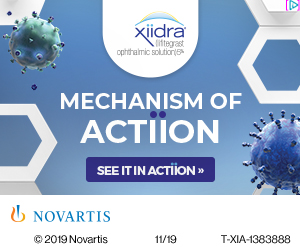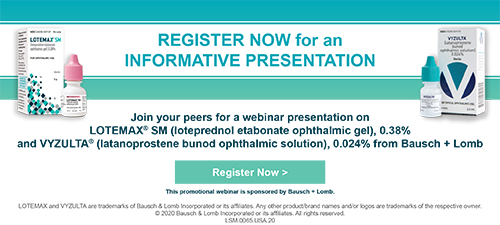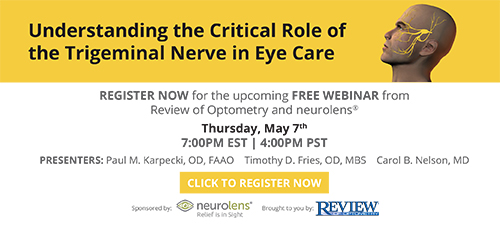
A
weekly e-journal by Art Epstein, OD, FAAO
Off the Cuff: A Brighter Shade of Pale
Along with the COVID outbreak came obsessive hand washing, social distancing, stay-at-home orders, and meeting and event cancellations. In response to the isolation and uncertainty COVID created, we’ve seen a dramatic increase in our virtual connections. Beyond telemedicine for continued patient care, we have been supported by online meetings and educated by remote cyber CE. Like many of you, I have been kept busy, perhaps too busy for such a disorienting time. Because the situation was so rapidly evolving, I’ve devoted much of OP coverage to sharing insight and advice about how to survive the outbreak and stay safe. I will continue to do that, just not today. I need a break from the stress and misery and death of COVID-19. So, for the moment, I want to focus on what I do best and what you do best—caring for others. Since dry eye is my personal passion, I thought I would share some exciting news about two novel and potentially game changing dry eye medications. First is Kala’s EYSUVIS™ 0.25% loteprednol etabonate ophthalmic suspension for the treatment of acute dry eye. Kala recently announced statistically significant positive results meeting both primary and key secondary endpoints in their STRIDE 3 Phase III clinical trial. What makes EYSUVIS™ especially exciting is that it will be the first 2-week temporary treatment indicated for managing dry eye signs and symptoms flares. Loteprednol has long been used off label for managing dry eye. Having an FDA-approved formulation with a dry eye indication is an important advance for both clinical and medicolegal reasons. Oyster Point’s OC-01 is entering Phase III clinical trials. OC-01, is a preservative-free selective nicotinic acetylcholine receptor (nAChR) agonist nasal spray, which directly stimulates the nasocilliary branch of the trigeminal nerve to facilitate basal tear production. What makes OC-01 especially intriguing its cutting-edge ability to support ocular surface homeostasis through indirect nasal application. So far, data for OC-01 looks promising with a logical mechanism of action and clinically broad effects. If all goes well, FDA approval should be forthcoming. What makes both of these new drugs exciting is that they offer novel targeted approaches to managing a rapidly growing patient population with largely unmet needs. It also signals a new willingness by the FDA to expand treatment options for dry eye.Editor's Note: Thanks to all who took our poll last week. I am still pondering whether to create an interactive online version of Optometric Physician Live, but want to reassure friends, fans and followers that any online presence would be in addition to the regular emailed Optometric Physician you get every Saturday morning. I am considering some very interesting approaches and will make a final decision in the next week or two. Hang in there…
|
|||||
 |
||
| Chloroquine and Hydroxychloroquine Retinal Toxicity Consideration in the Treatment of COVID-19 | ||||
The proposed doses of chloroquine (CQ) and hydroxychloroquine (HCQ) for treatment of COVID-19 (1,000 mg/day for 10 days, CQ; 800 mg first day then 400 mg/day for five days, HCQ) in many guidelines worldwide, are considerably higher than the maximum recommended daily safe doses of both agents (≤2.3 mg/kg/day, CQ; ≤5.0 mg/kg/day, HCQ) for development of retinal toxicity. Irreversible retinal damage can occur if the exposure to the safe doses is >5 years. It is not known whether exposure to high doses over a short period of time can also cause the damage. The authors recommended that before prescribing CQ or HCQ, a history of ocular disease is obtained to avoid the prescription, if appropriate. If either agent is to be used, routine baseline ocular examination is not absolutely necessary. Patients who do not have ocular disease should also be informed about the potential risk of retinal toxicity. Both agents, however, have not yet been proven to be beneficial to COVID-19. |
||||
SOURCE: Ruamviboonsuk P, Lai TYY, Chang A, et al. For Asia-Pacific Vitreo-Retina Society. Chloroquine and Hydroxychloroquine Retinal Toxicity Consideration in the Treatment of COVID-19. Asia Pac J Ophthalmol (Phila). 2020;9(2):85-7. |
||||
 |
||
| Medical mask or N95 respirator: When and how to use? | ||||
COVID-19 pandemic is now a global threat to human health reaching up to two million infected people all around the world. Since its first recognition in Wuhan, many topics were discussed intensively about COVID-19, both in the public and scientific community. Personal protective equipment and especially masks were among the hottest topics during this pandemic. Regardless of which mask is used, performing hand hygiene frequently with an alcohol-based hand rub or with soap and water if hands are dirty is the most effective preventive measure for COVID-19. The type of mask used when caring for COVID-19 patients will vary according to the setting, type of personnel/person and activity. Although the main transmission route for COVID-19 is droplets, during aerosol-generating procedures, airborne transmission may occur. Keeping the distancing when possible, and using medical masks and eye protection during close contact efficiently protects against respiratory diseases transmitted via droplets. Airborne precautions include goggles and respiratory protection with the use of an N95 or an equivalent mask respirator to prevent airborne transmission. |
||||
SOURCE: Azap A, Erdinç FŞ. Medical mask or N95 respirator: when and how to use? Turk J Med Sci. 2020; Apr 27. [Epub ahead of print]. |
||||
 |
||
| Precautions for and Prevention of Coronavirus Disease 2019 (COVID-19) Infection in the Eye | ||||
Although current studies have suggested that conjunctivitis is not a common presentation of coronavirus disease 2019 (COVID-19), several studies have reported the presence of Severe Acute Respiratory Syndrome Coronavirus-2 (SARS-CoV-2) in ocular secretions. As of publishing, coronavirus had not yet been successfully cultured from human tears or conjunctival swabs; neither had it been in SARS-CoV-2 nor SARS-CoV. However, live feline coronavirus has been isolated from conjunctival swabs. In addition, infection of COVID-19 through unprotected eye exposure had been suspected in several articles. Reports of ophthalmologists and otolaryngologists dying of COVID-19 also raised concern on ocular transmission. As a result, the authors strongly suggested that personal protective equipment (PPE) should cover the mouth, nose, and eyes of ophthalmologists, especially when conjunctivitis caused by SARS-CoV-2 is clinically indistinguishable from other viral follicular conjunctivitis. |
||||
SOURCE: Chen MJ, Chang KJ, Hsu CC, et al. Precaution and prevention of coronavirus disease 2019 (COVID-19) infection in the eye. J Chin Med Assoc. 2020; Apr 21. [Epub ahead of print]. |
||||
 |
||
| News & Notes | ||||||||
| SECO University Launches LIVE CE Webinar Series In the wake of the COVID-19 outbreak and subsequent cancellation and or postponement of CE meetings, SECO University launched SECO LIVE CE webinars approved by COPE for live CE. SECO LIVE launched with nine for-credit courses (13 hours of CE) as COPE has approved live CE online through June 30. In addition, SECO LIVE held two practice management how-to sessions on teleoptometry and setting up an online e-store, providing relevant content and training for today’s changing profession. Read more. |
||||||||
|
||||||||
| Eaglet Eye Announces New Payment Plan to Help Practitioners Eaglet Eye announced a new payment plan for the Eye Surface Profiler to help address the financial impact of the COVID-19 pandemic on specialty practices. Effective immediately, Eaglet Eye will offer a payment plan that allows for about 50% of the purchase price to be paid monthly over six months at no interest. Get more information. |
||||||||
| X-Cel Launches Bounce Back Program X-Cel Specialty Contacts launched the Bounce Back program to support specialty contact lens practices and patients in an effort to help them recover from COVID-19. The program offers extensive programs including patient recall support, simplified ordering with free add-ons, extended warranties to 120 days, reduced prices on fitting sets and spare lenses, shipping discounts through USPS First Class mail, direct shipments to patients, as well as ongoing educational events. Learn more. |
||||||||
| Ocular Therapeutix Announces Positive Topline Results of Phase III Dextenza Trial Ocular Therapeutix announced topline results from its Phase III clinical trial to evaluate the safety and efficacy of Dextenza for the treatment of ocular itching associated with allergic conjunctivitis. The company believes its product has potential as a hands-free therapy administered in the office setting as a bioresorbable, intracanalicular insert, designed to release the corticosteroid dexamethasone to the ocular surface for up to 30 days. In the Phase III trial, Dextenza met all pre-specified primary endpoints as demonstrated by a statistically significant mean change in ocular itching from baseline, on a subject-reported 5-point scale, at three time points on Day 8. Read more. |
||||||||
| M&S Announces VF Testing Breakthrough M&S Technologies partnered with the University of Melbourne to release the Melbourne Rapid Fields – Visual Field Suite (MRF), which consists of In-Clinic and Online Visual Field testing. The new MRF Visual Field Tablet is designed and calibrated to deliver consistent results, and to save space for testing on- and offsite. The interface is designed for ease of use and to reduce test time. Tests include: full-field 30-2, full-grid 24-2, macular 10-2, screening and visual acuity assessment. Patient data is auto‐populated for immediate, HFA-style reports. Call for more information: 847-763-0500. Learn about the company. |
||||||||
| Eye Designs Group Introduces Optical Specific Germ Shield / Sneeze Guard Eye Designs is introducing a new, optical specific freestanding protective Germ Shield / Sneeze Guard. Designed to sit on dispensing tables to protect staff and patients with social distancing, the product is 24 inches wide by 36 inches high and is custom made for the optical environment. The unique design features streamlined cutouts on both sides enabling opticians to reach around and properly fit eyewear. Currently there is limited stock of the Germ Shield / Sneeze Guards available, but more will be available in the coming weeks. They are sold individually or you individuals may inquire about quantity discount pricing. For more information, call 800.346.8890 or email info@eyedesigns.com Learn about the company. |
||||||||
|
Optometric Physician™ (OP) newsletter is owned and published by Dr. Arthur Epstein. It is distributed by the Review Group, a Division of Jobson Medical Information LLC (JMI), 19 Campus Boulevard, Newtown Square, PA 19073. HOW TO ADVERTISE |


